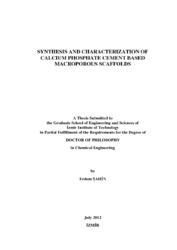Please use this identifier to cite or link to this item:
https://hdl.handle.net/11147/2941Full metadata record
| DC Field | Value | Language |
|---|---|---|
| dc.contributor.advisor | Çiftçioğlu, Muhsin | - |
| dc.contributor.author | Şahin, Erdem | - |
| dc.date.accessioned | 2014-07-22T13:48:38Z | |
| dc.date.available | 2014-07-22T13:48:38Z | |
| dc.date.issued | 2012 | - |
| dc.identifier.uri | http://hdl.handle.net/11147/2941 | - |
| dc.description | Thesis (Doctoral)--Izmir Institute of Technology, Chemical Engineering, Izmir, 2012 | en_US |
| dc.description | Includes bibliographical references (leaves: 254-267) | en_US |
| dc.description | Text in English; Abstract: Turkish and English | en_US |
| dc.description | xviii, 315 leaves | en_US |
| dc.description.abstract | The goal of this thesis is to synthesize unique, clinically relevant macroporous calcium phosphate cement blocks to be utilized both in vivo and in vitro tissue engineering applications. Calcium phosphate cements which essentially consist of hydroxyapatite or brushite are constantly improved to overcome their inherent shortcomings such as low strength, low functional porosity, and low resorption. Recent literature on the topic points to monetite forming cements as an alternative phase. A novel method to utilize monetite that is finer and stronger with respect to brushite in load bearing scaffold applications is introduced in the results section of this thesis as a contribution to ever growing literature on this scope. In the preliminary study on the conversion extent of apatite forming cement, ionic strength of the setting liquid was determined as the prime effective factor on monetite conversion extent. Subsequently brushite forming β-tricalcium phosphate – monocalcium phosphate monohydrate cement system was modified by NaCl and citric acid so that brushite formation was selectively inhibited. Singular and synergistic monetite promoting effects of NaCl and citric acid were determined by monitoring the kinetics of cement setting in excess setting liquid. Spectrometric studies revealed the difference in brushite and monetite crystal surface site density which enabled selective inhibition of brushite and promotion of monetite by the synergistic effect of NaCl anc citric acid. Proposed phase control mechanism enables tailoring the composition of biphasic cements comprising of a predetermined monetite content and brushite or hydroxyapatite. In the final stage of the thesis, size distributed NaCl particles were introduced into the cement paste containing optimum amount of citric acid to enable complete monetite formation. Resultant macroporous monetite blocks were characterized in terms of microporosity, macroporosity, density, morphology, strength, phase composition, and surface area. Interconnectivity of the cement was optimized based on the correlation of porogen size distribution and morphological data. | en_US |
| dc.language.iso | en | en_US |
| dc.publisher | Izmir Institute of Technology | en_US |
| dc.publisher | Izmir Institute of Technology | en_US |
| dc.rights | info:eu-repo/semantics/openAccess | en_US |
| dc.subject.lcsh | Calcium phosphate | en |
| dc.subject.lcsh | Tissue scaffolds | en |
| dc.title | Synthesis and Characterization of Calcium Phosphate Cement Based Macroporous Scaffolds | en_US |
| dc.type | Doctoral Thesis | en_US |
| dc.institutionauthor | Şahin, Erdem | - |
| dc.department | Thesis (Doctoral)--İzmir Institute of Technology, Chemical Engineering | en_US |
| dc.relation.publicationcategory | Tez | en_US |
| dc.identifier.wosquality | N/A | - |
| dc.identifier.scopusquality | N/A | - |
| item.openairecristype | http://purl.org/coar/resource_type/c_18cf | - |
| item.cerifentitytype | Publications | - |
| item.fulltext | With Fulltext | - |
| item.languageiso639-1 | en | - |
| item.grantfulltext | open | - |
| item.openairetype | Doctoral Thesis | - |
| Appears in Collections: | Phd Degree / Doktora | |
Files in This Item:
| File | Description | Size | Format | |
|---|---|---|---|---|
| T001076.pdf | DoctoralThesis | 12.75 MB | Adobe PDF |  View/Open |
CORE Recommender
Page view(s)
388
checked on Apr 28, 2025
Download(s)
212
checked on Apr 28, 2025
Google ScholarTM
Check
Items in GCRIS Repository are protected by copyright, with all rights reserved, unless otherwise indicated.